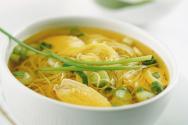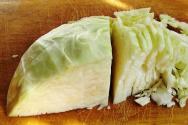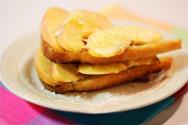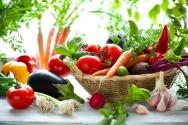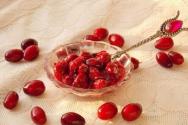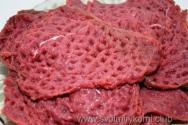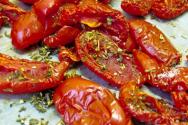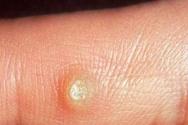Recipes for Karakalpak cuisine. Sour dough manti
The Republic of Karakalpakstan, located in the north-west of Uzbekistan, has its own unique language, customs and, of course, traditional dishes. Karakalpakstan is located in a desert zone, which undoubtedly affected the culture and local residents.
Karakalpak cuisine is an unusual mixture of dishes from many peoples of the world, but it is traditional food this republic will amaze any gourmet. It is usually very high in calories and quite simple, without using a lot of seasonings. Meat is one of the main components of any local dishes. The main meats consumed are lamb and beef, although some dishes are based on camel and horse meat. There is no pork in their diet, since most local residents adhere to the Muslim religion. Most dishes are “accompanied” by wheat flatbreads. The Karakalpaks wash down their food with tea mixed with milk.
Some of the most famous Karakalpak dishes are zhueri gurtik and kauyn aksaulak. The first refers to ancient types of food and is dumplings made from Dzhugar flour, while the second is finely crumbled fried pieces of dough, laid on melon jam and poured sour milk on top.
Often in Karakalpak cuisine there is a mixture of pieces of meat with dough, an example of which is such a dish as beshbarmak. Traditional dishes They are prepared infrequently; the most popular in Karalpakia are the “borrowed” ones: pilaf, lagman, manti, dumplings.
WITH juery edge Another traditionally Karakalpak dish called durama. When preparing it, boiled meat is mixed with dumplings. It is interesting that the meat part is often crumbled by men, and the dough by everyone else present. Durama is served with crushed onions with broth fat, which is called duzlyk in Karakalpakstan.
The first and second courses here are Dzhugara And mung bean, rice, beans, various grains. They can also be used as a side dish. When studying the menu of the Karakalpaks, you should not confuse them with the Uzbeks. Even with the same or similar dishes, two completely different peoples coexist in one country, and mixing one with the other can simply offend someone. The cuisine of the republic is very different from other Central Asian ones due to the food consumed exclusively in this area.
Due to the fact that Karakalpakstan was once part of the USSR, many Russians and Ukrainian dishes. Local residents enjoy eating borscht, dumplings and much more. Products for cooking are bought in markets, the number of which is huge throughout Uzbekistan. You can find anything on them: from clothes to knives and frying pans. It should be remembered that, despite the fact that mainly women cook in Central Asian countries, many dishes can be entrusted exclusively to the male hand, which the Karakalpaks closely monitor.
Karakalpak cuisine
Among the meat dishes consumed here are beef, lamb, camel meat, horse meat, rabbit meat and poultry. The most popular ones are lamb and beef. They don't eat pork at all.
The first and second courses include dzhugar, mung bean, dzhugar flour, millet, rice, beans, sorghum and other cereals as an integral part or as a side dish. A lot of potatoes and vegetables are consumed.
The main methods of heat treatment are boiling and frying. Combinations of meat and boiled dough are widespread.
The most common dishes are beshbarmak, pilaf, lagman, manpar, shavli, manty, samsa, dumplings, Uzbek-style shorpa, mastava soup, noodle soup in broth (recipes are given in the section " Uzbek cuisine»).
Almost all dishes are served with tortillas made from wheat flour.
The food is washed down green tea or black tea with milk.
Recipes for Karakalpak cuisine
1. FeedFresh carp is cut into large pieces and boiled in salted water. When ready, remove the fish, cool it and separate the meat from the bones.
The dough is rolled out thinly, cut into pieces, boiled in salted water, and then cut into strips. Finely chop the onion and fry it. Then the fish, noodles and onions are mixed, poured with fish broth so that it just covers the ingredients, and the broth is served separately in a large bowl.
Carp 300, onions 75, wheat flour 75, salt.
2. TuramaLamb, smoked lamb brisket and fat tail fat are boiled in large pieces, then removed from the broth, cooled and cut into strips.
The dough is rolled out thinly, cut into pieces, boiled and cut into strips. The onion is finely chopped and fried. Meat products, noodles and onions are mixed, sprinkled with pepper and poured with broth.
Lamb 50, smoked lamb brisket 40, fat tail lard 10, onion 50, flour 75, ground black pepper, salt.
Section: Cuisines of the peoples of the former USSR
Based on materials collected by I. Feldman and others.
38th page of the section
Karakalpak cuisine
Dish recipes Karakalpak cuisine
For each national cuisine, a single numbering of recipes is used.
The recipes are mainly based on one serving.
The weight of the products is indicated in grams.
Karakalpak cuisine
Meat dishes consumed here include beef, lamb, camel meat, horse meat, rabbit meat and poultry. The most popular ones are lamb and beef. They don't eat pork at all.
The first and second courses include dzhugar, mung bean, dzhugar flour, millet, rice, beans, sorghum and other cereals as an integral part or as a side dish. A lot of potatoes and vegetables are consumed.
The main methods of heat treatment are boiling and frying. Combinations of meat and boiled dough are widespread.
The most common dishes are beshbarmak, pilaf, lagman, manpar, shavli, manty, samsa, dumplings, Uzbek-style shorpa, mastava soup, noodle soup in broth (recipes are given in the “Uzbek Cuisine” section).
Almost all dishes are served with wheat flour tortillas.
The food is washed down with green tea or black tea with milk.
Recipes for Karakalpak cuisine
1. Feed
Fresh carp is cut into large pieces and boiled in salted water. When ready, remove the fish, cool it and separate the meat from the bones.
The dough is rolled out thinly, cut into pieces, boiled in salted water, and then cut into strips. Finely chop the onion and fry it. Then the fish, noodles and onions are mixed, poured with fish broth so that it just covers the ingredients, and the broth is served separately in a large bowl.
Carp 300, onions 75, wheat flour 75, salt.
2. Turama
Lamb, smoked lamb brisket and fat tail fat are boiled in large pieces, then removed from the broth, cooled and cut into strips.
The dough is rolled out thinly, cut into pieces, boiled and cut into strips. The onion is finely chopped and fried. Meat products, noodles and onions are mixed, sprinkled with pepper and poured with broth.
Lamb 50, smoked lamb brisket 40, fat tail lard 10, onion 50, flour 75, ground black pepper, salt.
Also about the cuisines and customs of the peoples of the former USSR, see the sections:Represents an original national cuisine with elements of the culinary art of neighboring Central Asian peoples: Uzbeks, Turkmens, Kazakhs.
Kitchen features
Meat dishes consumed here include beef, lamb, camel meat, horse meat, rabbit meat and poultry. The most popular ones are lamb and beef. Since the Karakalpaks are Muslims by religion, they do not eat pork dishes.
They go into first and second courses as an integral part or as a side dish. Dzhugara , mung bean, dzhugar flour, millet , rice , beans , sorghum and other cereal crops. A lot of potatoes and vegetables are consumed.
The main methods of heat treatment are boiling and frying. Combinations of meat and boiled dough are widespread. Often Karakalpak food is a mixture fried meat with boiled dough.
The most common dishes are edge , pilaf , lagman , manpar , shavlya , manta rays , samsa , dumplings , shorpa , mashaba soup, noodle soup in broth.
Turama - finely chopped meat with dumplings
Especially favorite traditional meat dish Karakalpak is finely chopped meat with dumplings - turama (durama). Name of the dish Turama comes from the word tour- crumble. For dumplings - gurtik, mainly jugar flour was used. The boiled meat is usually finely chopped by adult men, and the dumplings are crumbled by the rest of those present. After this, the finely chopped dumplings and meat are mixed. For three or more people, turama is served on a common platter, with broth added to the dish on top. Along with the broth, a sauce is sometimes poured into the turama - the so-called tuzlyk, or serebe (a mixture of chopped onions and fat from cooked meat). This dish has analogues in Nogai ( turoma), Turkmen ( dograma) and Uzbek ( Naryn) cuisines, which in turn are varieties beshbarmak.
Main courses and soups
- Dymdama- stewed meat with vegetables
- Dolma - cabbage rolls
- Kabob - shashlik
- Kuurdak- fried meat with vegetable side dish.
- Katykli - soup based katyka
- Moshkichiri- rice porridge With we wave(mung beans)
- Mashkhurda - rice soup with a wave
- Samsa- pies
- Chalap - cold soup based on katyk
- Chuchpara - dumplings.
- Shavlya - rice porrige
- Shurpa - potato soup with meat, the word is commonly used simply to mean soup.
Fermented milk products
- Katyk- fermented milk drink made from boiled milk.
- Suzma- sour curd mass after expressing katyk.
- Kurut- dried suzma balls with added salt and pepper.
- Ayran- diluted in boiled water cold water Suzma with the addition of ice cubes and apples.
- Kumis- fermented milk drink from mare's milk
Write a review about the article "Karakalpak cuisine"
Literature
- Isai Abramovich Feldman. Cuisine of the peoples of the USSR. - Kyiv, 1990. - P. 238. - ISBN 5-88520-098-X.
Links
An excerpt characterizing Karakalpak cuisine
“Ah, Natasha,” said Sonya, looking enthusiastically and seriously at her friend, as if she considered her unworthy to hear what she had to say, and as if she were saying this to someone else with whom one should not joke. “I once fell in love with your brother, and no matter what happens to him, to me, I will never stop loving him throughout my life.”Natasha looked at Sonya in surprise and with curious eyes and was silent. She felt that what Sonya said was true, that there was such love as Sonya spoke about; but Natasha had never experienced anything like this. She believed it could be, but she didn't understand.
-Will you write to him? – she asked.
Sonya thought about it. The question of how to write to Nicolas and whether to write and how to write was a question that tormented her. Now that he was already an officer and a wounded hero, was it good of her to remind him of herself and, as it were, of the obligation that he had assumed in relation to her.
- Don't know; I think if he writes, I’ll write too,” she said, blushing.
“And you won’t be ashamed to write to him?”
Sonya smiled.
- No.
“And I’ll be ashamed to write to Boris, I won’t write.”
- Why are you ashamed? Yes, I don’t know. Embarrassing, embarrassing.
“And I know why she will be ashamed,” said Petya, offended by Natasha’s first remark, “because she was in love with this fat man with glasses (that’s how Petya called his namesake, the new Count Bezukhy); Now she’s in love with this singer (Petya was talking about the Italian, Natasha’s singing teacher): so she’s ashamed.
“Petya, you’re stupid,” Natasha said.
“No more stupid than you, mother,” said nine-year-old Petya, as if he were an old foreman.
The Countess was prepared by hints from Anna Mikhailovna during dinner. Having gone to her room, she, sitting on an armchair, did not take her eyes off the miniature portrait of her son embedded in the snuffbox, and tears welled up in her eyes. Anna Mikhailovna, with the letter, tiptoed up to the countess's room and stopped.
“Don’t come in,” she said to the old count who was following her, “later,” and closed the door behind her.
The Count put his ear to the lock and began to listen.
At first he heard the sounds of indifferent speeches, then one sound of Anna Mikhailovna's voice, making a long speech, then a cry, then silence, then again both voices spoke together with joyful intonations, and then steps, and Anna Mikhailovna opened the door for him. On Anna Mikhailovna's face was the proud expression of an operator who had completed a difficult amputation and was introducing the audience so that they could appreciate his art.
“C”est fait! [The job is done!],” she said to the count, pointing with a solemn gesture at the countess, who was holding a snuffbox with a portrait in one hand, a letter in the other, and pressed her lips to one or the other.
Seeing the count, she stretched out her arms to him, hugged his bald head and through the bald head again looked at the letter and portrait and again, in order to press them to her lips, she slightly pushed the bald head away. Vera, Natasha, Sonya and Petya entered the room and the reading began. The letter briefly described the campaign and two battles in which Nikolushka participated, promotion to officer, and said that he kisses the hands of maman and papa, asking for their blessing, and kisses Vera, Natasha, Petya. In addition, he bows to Mr. Sheling, and Mr. Shos and the nanny, and, in addition, asks to kiss dear Sonya, whom he still loves and about whom he still remembers. Hearing this, Sonya blushed so that tears came to her eyes. And, unable to withstand the glances directed at her, she ran into the hall, ran up, spun around and, inflating her dress with a balloon, flushed and smiling, sat down on the floor. The Countess was crying.
-What are you crying about, maman? - Vera said. “We should rejoice at everything he writes, not cry.”
This was completely fair, but the count, the countess, and Natasha all looked at her reproachfully. “And who did she look like!” thought the countess.
Nikolushka's letter was read hundreds of times, and those who were considered worthy of listening to it had to come to the countess, who would not let him out of her hands. Tutors, nannies, Mitenka, and some acquaintances came, and the countess re-read the letter every time with new pleasure and each time, from this letter, she discovered new virtues in her Nikolushka. How strange, extraordinary, and joyful it was for her that her son was the son who had barely noticeably moved with tiny limbs inside her 20 years ago, the son for whom she had quarreled with the pampered count, the son who had learned to say before: “ pear,” and then “woman,” that this son is now there, in a foreign land, in a foreign environment, a courageous warrior, alone, without help or guidance, doing some kind of manly work there. All the world's centuries-old experience, indicating that children imperceptibly from the cradle become husbands, did not exist for the countess. The maturation of her son in every season of manhood was as extraordinary for her as if there had never been millions of millions of people who matured in exactly the same way. Just as she couldn’t believe 20 years ago that that little creature that lived somewhere under her heart would scream and begin to suck her breast and start talking, so now she couldn’t believe that this same creature could be that strong, a brave man, an example of the sons and men he was now, judging by this letter.
